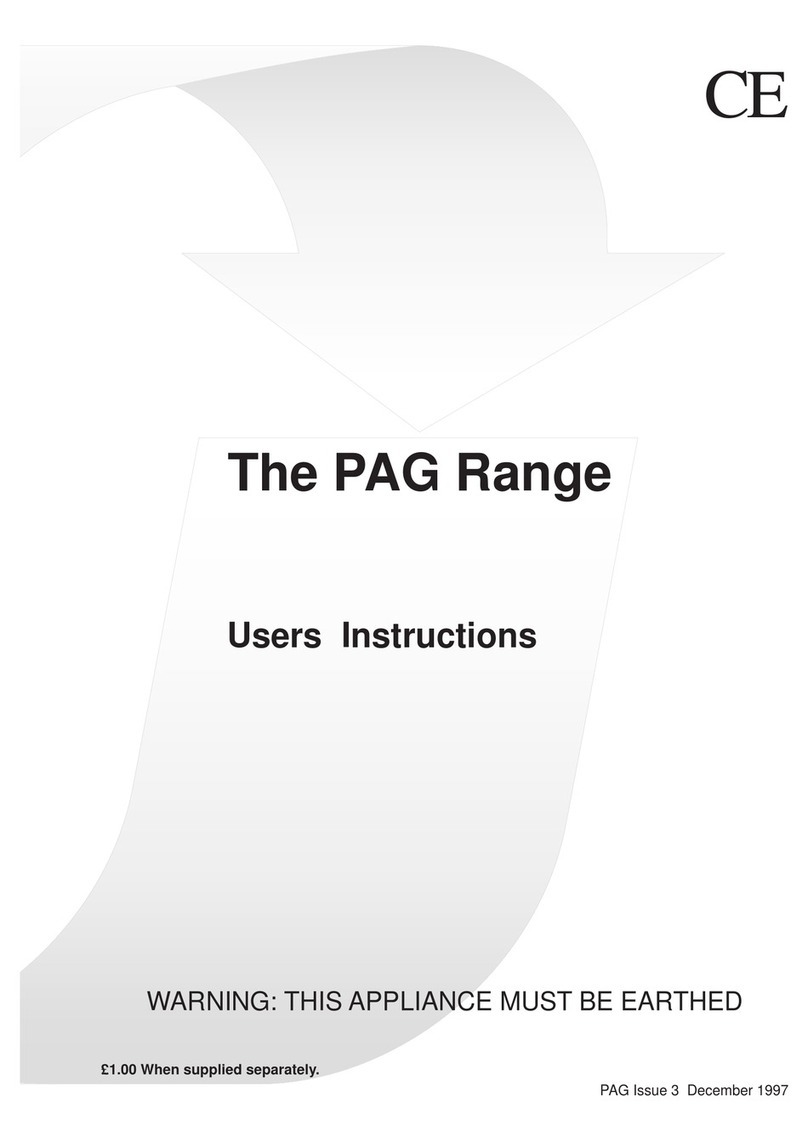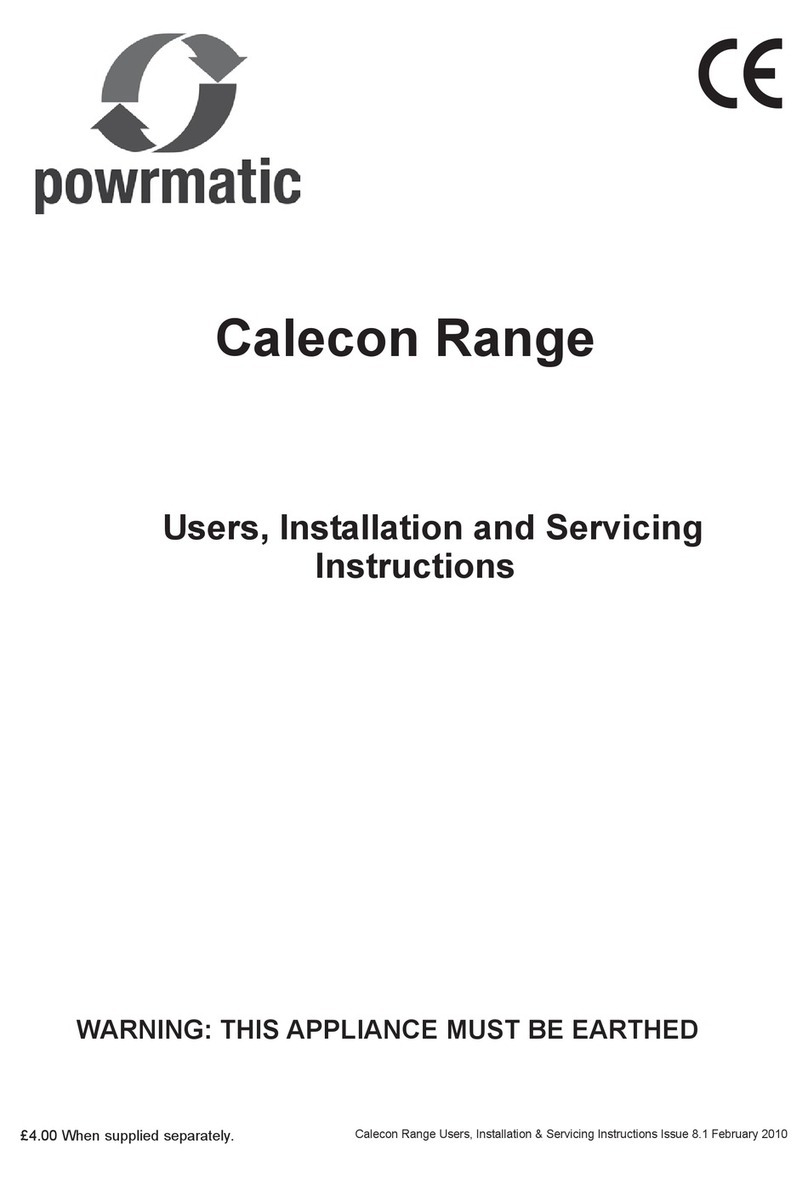
6
4. Installation of Air Heater(s)
4.1 General
Before installation, check that the local distribution conditions,
nature of gas and pressure, and adjustment of the appliance are
compatible.
The air heater must be installed in accordance with the rules in
force and the relevant requirements of any fire regulations or
insurance company's requirements appertaining to the area in
which the heater is located, particularly where special risks are
involved such as areas where petrol vehicles are housed, where
cellulose spraying is carried out, in wood working departments
etc.
NV/C units are supplied with the centrifugal fan/silencer section
seperate from the heater which must be fitted at the rear of the
NV heater i.e the fan is blowing across the heat exchanger.
The following minimum clearances must be observed for
installation and servicing .
HS Clearance (looking at front of heater) 1.0m
LHS Clearance (looking at front of heater) 0.2m
Top of the heater to ceiling 0.2m
ear of heater to nearest wall 0.6m
(Depending on flue system used)
For multi air heater installations the following minimum distances
between units must be observed.
Between units, side to side 3.0m
Between units, back to back 3.0m
ecommended mounting heights, floor level to the underside
of the unit, are:-
NV10F - 30F 2.5m - 3m
NV40F - 150F 3m - 5m
NV/D Models Mounting heights not applicable
All models must not be installed at a height of less than 2.5m
to the base of the unit.
Any combustible material adjacent to the air heater and the flue
system must be so placed or shielded as to ensure that its
temperature does not exceed 65 °C.
When NV modular components are used in conjunction with
the heater each component must be individually supported.
4.2 Fitting the Air Heater
The air heater may be installed either:
a) suspended from suitable vertical drop rods,
chains or straps.
b) on specifically designed cantilever brackets from a
non-combustible wall.
c) on a level non-combustible surface. The surface must
not extend past the front edge of NV/F heaters.
The method of installation must be capable of adequately
supporting the weight of the unit (See Table 2, Page 3) and any
ancillary equipment. Before installing the heater the existing
structure must be inspected to ensure it is suitable. All supports
should be protected against the effects of rust or corrosion.
Threaded drop rods must have lock nuts fitted that are tightened
down onto the 10mm fixings in the heater.
If reducing noise levels is important the heater should be
insulated from the structure by installing it on suitable anti-
vibration mountings. In all such cases and when the heater is
suspended it is essential that all gas, duct, and electrical
connections to the heater are made with flexible connections
to maintain continuity of connection.
4.3 Flue/Combustion Air Duct System
All models are supplied as standard with a top flue outlet and
the flue outlet and combustion air sockets are loose inside the
controls section.
or flooded or in any position adjacent to an extraction system
which is carrying flammable vapour.
Grilles or louvres should be so designed that high velocity air
streams do not occur within the plant room.
The basic minimum effective area requirements of the air vents
are as follows:
(a) Low Level (inlet)
(1) for heaters of total rated heat input less than 60kW:
9cm² per kilowatt of rated heat input.
(2) for heaters of total rated heat input 60kW or more:
540 cm² plus 4.5 cm² per kilowatt in excess of 60
kW total rated input.
(b) High Level (outlet)
(1) for heaters of total rated heat input less than 60kW:
4.5cm² per kilowatt of rated heat input.
(2) for heaters of total rated heat input 60kW or more:
270 cm² plus 2.25 cm² per kilowattin excess of 60kW
total rated input.
3.6 Air Distribution System
Where single NV/F units are required to cover a large floor
area, and in buildings with high roof or ceiling heights Calecon
thermal economiser units should be fitted to ensure even heat
distribution and minimise stratification.
Care should be taken to avoid impeding the air throw with
racking, partitions, plant or machinery etc. Various outlet
configurations are available as optional extras to modify the air
throw pattern to suit particular site conditions.
For ducted units all delivery and return air ducts, including air
filters, jointing and any insulation or lining must be constructed
entirely of materials which will not contribute to a fire, are of
adequate strength and dimensionally stable for the maximum
internal and external temperatures to which they are to be
exposed during commissioning and normal operation.
Where inter-joist spaces are used as duct routes they should be
suitably lined with a fire-resisting material.
A full and unobstructed return air path to the air heater(s) must
be provided.
If the air heater(s) is installed in a plant room the return air
intake(s) and the warm air outlet(s) from the heater(s) must be
fully ducted, into and out of the plant room to avoid interference
with the operation of the heater.
The openings in the structure of the plant room through which
the ducting passes must be fire stopped.
Care must be taken to ensure that return-air intakes are kept
clear of sources of smells and fumes, and where there is any
possibility of pollution of the air by dust, shavings etc.,
precautions must be taken to prevent contamination.
If necessary suitable barrier rails should be provided to prevent
any combustible material being placed within 900mm of the
outlets.
3.7 lectrical Supply
Wiring external to the air heater must be installed in accordance
with the I.E.E. egulations for Electrical Installations and any
local regulations which apply.
All standard heaters are supplied by 230V - 1ph, 50Hz. The
method of connection to the main electricity supply must:-
- facilitate the complete electrical isolation of the unit(s)
- be in a readily accessible position adjacent to the unit(s)
- serve only the unit(s)
- have a contact separation of at least 3mm in all poles. See the
accompanying wiring diagram for the heater electrical
connections
NV centrifugal fan/silencer units can also be supplied for 400V
3N, 50Hz.





























